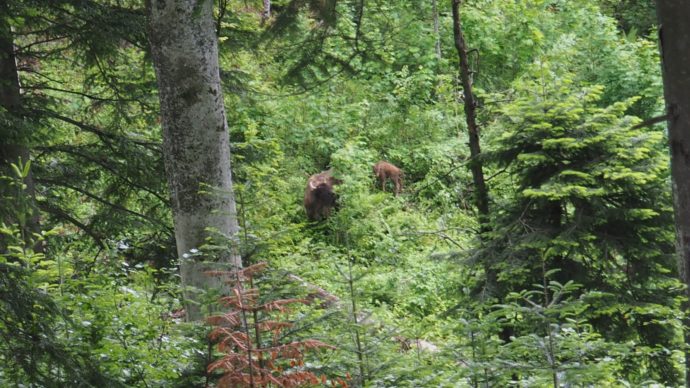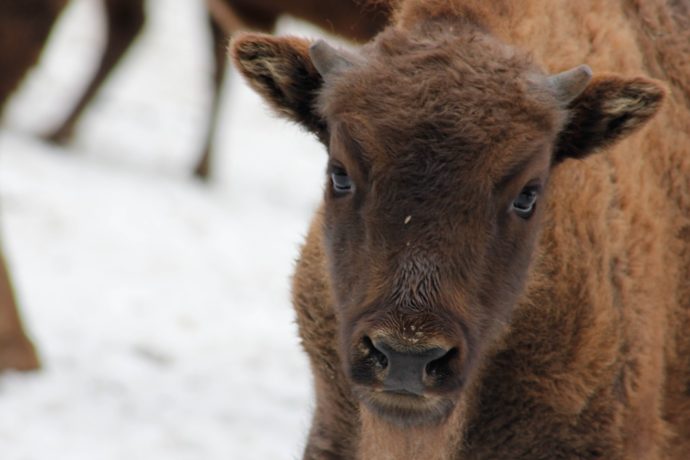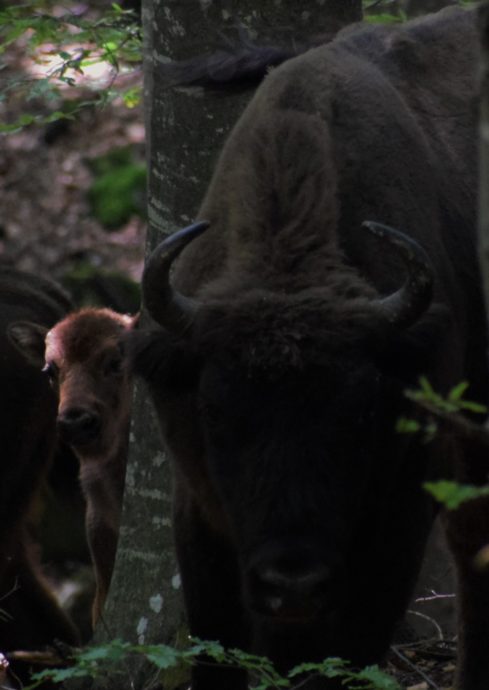New life, wild life in the Southern Carpathians

The first calve of 2020 staying close to his mother / MATEI MICULESCU
The first bison calve has been spotted this year by rangers in the Bison Hillock.
The success of a rewilding programme stands in many factors, but one of the key ones is having new life being born in the wild. At least 20 calves have been born in the wild in the Southern Carpathians since the beginning of the rewilding initiative by Rewilding Europe and WWF-Romania.
Birth and growth
Bison calves are usually born in between May and July, with enough time for them to get strong and ready before the winter, but there are exceptions where females give birth also in winter. The pregnancy is of about nine months.
On average, male calves weigh approximately 27 kg at birth, and females around 24 kg. After six months a calf weighs about 100 kilograms. While females have a higher increase in body mass in their first year, their growth rate is comparatively slower than that of males by the age of 3–5. At maturity female bison can reach over 500 kg while males are known to surpass 800 kg. Bulls reach sexual maturity at the age of two, while cows do so in their third year.

Claves will put on about 400 to 600 kg from birth to maturity and reach up to 2 meters in length. / BIANCA ȘTEFĂNUȚ
First steps in the wild
Female bison leave the herd to give birth in a quiet and safe place in order to make sure the fragile baby is safe from the huge bison and other threats. A bison calf follows its mother closely, especially in the first week after birth. Cows that have given birth are very caring and alert. When bison calves are slightly older they show play behavior, and together grow up in the herd. Calves drink for several months from their mothers however within a few weeks they already start eating from vegetation as well.
The calves have reddish fur at birth, but after a few months, the fur begins to change to brown-chocolate and they start to mold like adults do. The color and density of bison fur varies with the season.
Mixed groups consist of adult females, calves, young aged 2–3 years, and young adult bulls.
Wildlings of the Bison Hillock
Life Bison rangers have spotted in their monitoring sessions this spring about 8 baby bison born last year roaming with herds in the Țarcu Mountains.
„There could be more calves. Counting them is not easy as they quickly disappear in the forest under the watchful gaze of the protective group that keeps them hidden behind massive bodies. ”sais ranger Daniel Hurduzeu.
Some of the calves from previous years noticed by the rangers are staying close to the group.
The calves are yet too young and too far away to determine their age or gender. We also can’t tell for sure which calf belongs to which female as suckling calves are a rare sight. Mothers are always on the watch and alert the group to move on when they get a scent of human presence.
Surviving and thriving
Main threats to the calves are old bulls which can, in their quarrels, trample the little ones. Young males can easily lose battles with experiences bulls. Stray dogs from nearby villages or sheepfolds can also chase and injure calves if they can get them separated from the herd; if the calves are weak they can be attacked by bears or wolves;
A danger for all bison is overgrazing, especially with cattle because cattle can change the composition of meadows or grasslands with plants less valuable for biodiversity and less nutritive which affects the milk of the mothers and the diet of the entire herd. Poaching of other species can disturb also the environment, and thus the balance essential for the development of new generations of bison.
This awareness is very encouraging to see, these animals have really adapted to the wild and are more cautious than they would have ever been in a reserve or breeding center. We are on the right path as they will also teach these behaviors to their young thus helping future generations thrive.

Bison Calve from 2019 / TRISTIAN HERBERT
Power in numbers
The rewilding initiative has a benefic impact on the landscape and people if bison roam free in large numbers in the Southern Carpathians, sculpting the environment and maintaining the necessary and fragile balance, so important for biodiversity and for the wellbeing of us all.
8+ calves is the highest number yet to be seen in the Bison Hillock and we hope this year we will see even more claves being born and surviving to become the strong adults.
- Follow the action in the field on the Rewilding Southern Carpathians Facebook page
- Book an experience in the wild with European Safari Company